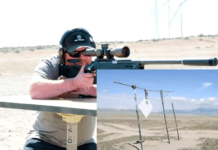You hear an awful lot about “muzzle flip” in the gunblogosphere. Much of it right here. At the risk of preempting an Ask Foghorn post, I’ll say this about that. You can have a little bit of this (the handgun’s muzzle or barrel “flipping” upwards after you pull the trigger) or a little bit of that (a heavy gun that reduces muzzle rise). At the risk of quoting former Prime Minister Tony Blair, there is a third way. Learn to work with—or at least not against—muzzle flip . . .
The big problem with muzzle flip is that shooters tend to pull the trigger before the barrel has stabilized and the sights are back on target. Once the shooter gives up trying to control the gun (if they even tried), they tend to simply shoot it dry. With a lot-less-than-spectacular results. This is especially true in a self-defense situation, where the tendency to freak out and fire willy-nilly (to use the technical term) is enormous.
We’ve already looked at the importance of forcing yourself to slow down in a defensive gun use (DGU) by realizing that adrenalin has altered your time perception; you have LOTS more time than you realize. I’ll say it again: if you slow down, your chances of being the most accurate (i.e. alive) guy in the room rise dramatically.
And here’s what you can do with that time: wait between double taps (a.k.a., closely paired groupings) to get a sight picture (i.e, for the muzzle flip to subside). It will take ages. An eternity. But it’s worth it. A world-class videogamer told me that he’d go into a room, let everyone blaze away and then [relatively] slowly pick them off. Like that.
A good way to make that happen: don’t let the trigger reset until you see the sight picture. Pull the trigger. BANG! BANG! Then hold the trigger down until you’ve got a target in your sights. Let the trigger out until it resets (feel it) and shoot again. BANG! BANG!
Wayne demos it here (cupping to let us see the trigger more closely). Like any other exercise try it slowly until you get it. Then speed up. Maybe. In any case remember: only the rounds that hit the target count. Accuracy then speed.




As always…
1. Sight picture
2. Trigger control
3. Follow through
And #3 is just keeping the trigger to the rear until you reacquire #1. The nice thing about this is that although it’s slower to begin with, if you have a firearm with a short reset (as the Glock has), this will allow you to use it. Bouncing off the trigger immediately just requires you to reposition your finger and take up all the slack again. If you stay on the trigger and feel the reset, since you already have your sight picture, you can immediately begin applying pressure, and get your next shot off very quickly. You waste no movement, and your speed is limited only by the time it takes to get that sight picture.
I see the willy nilly shooting all the time a the range, and they usually miss the entire target with their follow up shots.
I certainly agree that one should always reset their trigger no matter what type of shooting they are doing. This adds a lot of discipline around trigger control which is, of course, a good thing.
However, I respectfully disagree with beginning the reset until you are on target. Once the gun fires, the reset should be immediate and so that when you regain the sights you are ready to press out.
Controlling (or working with) muzzle flip is all in the grip assuming that you picked a caliber that you could control.
Another way to avoid muzzle flip – the extremely light (12 oz empty) S&W Model 360 scandium J-frame in .357 mag. I have a 3″ “kit gun” version (adj sights), and with the 158gr .357 loads, it has no muzzle flip – it just slams back into the web of your hand as if someone had smacked you with a ball-peen hammer, but has no muzzle flip. I would describe the recoil as somewhere between painful and @%$%^&#!!, but that’s the trade-off for a nearly unnoticeable carry gun. I wear a padded shooting glove on the range, and practice more with .38+P loads, but it has no muzzle flip. I’m not sure that gives you any faster follow-up shots, because you start anticipating the pain and wanting to postpone it.
Comments are closed.